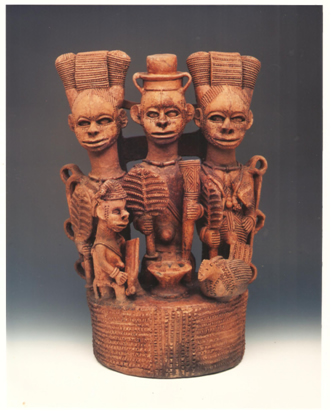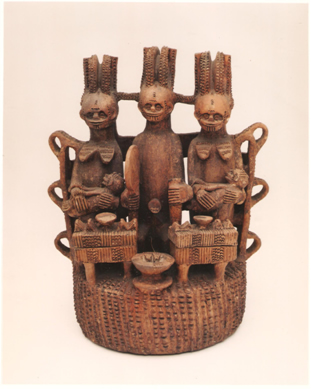Articles About Art - Images of Yam Gods
Art Information > Art Articles
> Images of Yam Gods
IMAGES OF YAM GODS: by Dr. Bridget Nwanze, University of
Port Harcourt, Nigeria
ABSTRACT
This paper describes the image of Ifejioku the yam god of Ossissa.The aim is to provide the
socio-religious background for understanding the divine origin and the sacred nature of yams in the
traditional belief of the Ossissa Igbo people. Ossissa is in the southern western part of Igbo
cultural area. The Igbo, most often referred to as Ibo, are a group of about six million people
located in southwestern Nigeria.The Igbo are the second largest group of the west African country,
Nigeria and have multiple dialects within the language. Interviews conducted with
some elders who are familiar with traditional custom of the village in February 2008 revealed that the
ordinarily simplified everyday way of life of the Ossissa Igbo man is centered around religion and
ancestors.The basic needs, it is believed can only be met if the ancestors give a nod of approval to
various requests.These requests range from right of life to the pleasure of the world. Hence for them
every visitor is greeted with an offer and breaking of kola nut which is preceded with pleasantries
and words of adoration for the forefathers and gods. Ossissa indigenes like many Igbo tribes celebrate
culture especially during the new yam festival which heralds the harvesting of yam crops.This
signifies the importance of the crop to their culture. It comes with dedication and paying of homage
to the gods for giving them a plentiful bounty. These ancestors are represented by images. The images
are symbolic and revered. The local tradition was that the images were made by women potters. They are
various and indigenous to their culture
IDENTITY
Religion is the controlling principle in Ibo existence. Although Christianity reached Ossissa as
early as 1896, traditional religious worship is still visible. The Ifejioku sculptural terracotta of
Ossissa is a symbolic image which represents the yam god – Ifejioku. This Ifejioku in sculptured
terracotta form convey very little of the impression they give in their actual place of use. Although
about eight different pieces have so far been discovered, extant whole pieces exist only in foreign
museums, especially in the Museum of Scotland, Edinburgh and the British Museum in London.
In Nigeria, very few of these terracottas exist. In Benin Museum, there exists partly broken
Ifejioku pieces while fragments of few of them have been found both in the National Museum in Lagos
and in the shrine of Ifejioku in Ossissa.
This paper is intended to relate three of the genre to its religious environment.
The existence of the divine Being and the invincible spirit world is natural to them.
The three pieces of sculptural terracotta chosen here for description indicate that the number of
figures on the earthenware vary. They all consist of a major figure, invariably male, flanked on both
sides by subordinate females and males in varied small sizes. Like a collection of character in a
play, they wear a number of adornments peculiar to the area and carry a number of objects typical of
the area. While the priests were the custodians of these objects, the creations were by craftsmen and
artists who worked within the context of customs. Their imagination centered around and was informed
by the culture and scenes around them.
Three Ceramic altar pieces for the New Yam Harvest:



The Ossissa terracottas show themselves as a visual elegance with some functionality. They show
figures in their full bloom. The hairstyle must have been worn only by the wives of chiefs and also
made by only specialized hands. In the female figures, the potters have exemplified basic social roles
of women in the society – pregnant, nursing and serving as companions. The creation of women on
the ritual piece is contrary to the local idea that only males were allowed to worship at Ifejioku
shrine and that women do not own Ifejioku pots or shrine. Perhaps the reason for the centralization of
the male figure and the relationship between the various other forms on the Ifejioku sculptural pieces
is due to the people’s beliefs. Chief Izuegbu, one of the indigenes interviewed on the issue
opined that Ifejioku is an occupational deity because it serves the spiritual and material needs of
the people whose major occupation is farming. The people believed in the invisible world and the
remoteness of the supreme God, Chukwu, it was necessary to reach him through intermediaries.
These intermediaries are usually famous men who lived and died amongst them and are believed to live
in an invisible world. He further stated that farming was mainly a man’s occupation with
the support of his family members.
The oral tradition – according to another informant, Okwudike, which is historical in nature
claims that the beliefs of the people led them into the creation of art forms like the Ifejioku
terracotta, which ultimately served as intermediaries to Almighty God ‘Chukwu’. During the
new yam festival, prayers are said and blood sacrifice is sprinkled on the fragment of the images in
the shrine. Imagination led to variety of creativity, which at the end of the day suited the feelings
of the people. The artists served as intermediaries between the cult priests and their thoughts. They
needed more than imagination to be in contact with their fore – fathers. Okwudike stressed
that ‘farms belonged to men as heads of families’. Others also believed that imagination
of the worshipers may have spurred such creations as the Ifejioku terracotta.
MALE DOMINACE
On the reason for the sex of the central figure on the terracotta, the priests and elderly men
informed the researcher that their forefathers were great farmers and since it was the tradition of
the people to venerate ancestors, Ifejioku was conceived as farmers spirit who ensures productivity
and fertility. Although women and children also farmed, there was a choice of the male as a dominant
figure, a situation that mirrors male preference, and accepted superiority over women in public
domain. They believe that Ifejioku is a man who had wives whose duties were to produce children that
were needed to help in the farms. The presence of the central male figure as well as his Ikenga shows
the force that directs achievement. The values appreciated by members of the community regard
ancestors as mainly dead male parents. God is regarded as a man. The traditional ruler is a man.
Lineage is counted through the male line. Consequently, it should not look strange that the male
figure is projected. Female ancestors are not usually revered. The Ikenga, an altar of the hand
by which notables gain good fortune is purely owned and worshipped by men. Since those really treated
as deities are those who took title, married, had children and were successful farmers, it was obvious
why family members and other objects were included in the tableaux. In Oba Nwabueze’s opinion,
‘creating their ancestors without the family members could cause loneliness for the god’.
He needed companions to function and polygamy was also common practice in Ossissa. According to
another indigene, the terracotta reminds Ossissa indigenes of the role of man as well as family
members in farming. They are therefore believed to be portraits of respected chiefs or headsmen
who have died. On the question of whether the Ifejioku terracotta could be molded without the male
figure, one chief responded with the proverb “without the thumb, the hand cannot hold a
cutlass” underlining the indispensability of the man.
CONCLUSION
By associating these sculptures with ancestors, they have been highly charged with meanings.
They also seem to carry complex symbolic messages. Nevertheless their presence engages the
participation of living descendants and their ancestors. The artists may have believed that in order
to please the gods, there was need to present him with the favorable conditions he enjoyed while on
earth as well as create such offerings that may be acceptable by him. The belief by all is that the
identity and presence of these ancestors are inextricably bound to the terracotta. This presence
and power of past leaders or ancestors affirm the social expectation of the ruling chiefs to undergo
same process when they die. It should be evident at this point that through the synthesis of Ifejioku
art forms, there is an establishment of social and spiritual order through artistic creation.
Our oral literature being the source of the belief of the people cover a greater part in the realm of
Ossissa art. The human body is here used as a metaphor for the social body. The male
figure represents a chieftain with signs of status. Stories from everyday occurrences stressing
moral values and precedents leading to fame are used as basis to form logic to drive home
points. The artist on his part combines this logic with psychology through imagination to bring
about an accepted conclusion. The creators of Ifejioku pieces have also used symbolic aesthetic
qualities to create feelings of fear and commitment. Thus because written literature that could
remind worshippers of the past is missing, memory is aided by the use of symbols and images.
Such images like the Ifejioku is re-enacted in rituals and during the new yam festivals. The
artists have here created values expressing their individual feelings and preference as well as
communal values of the society. The Ifejioku terracotta is an embodiment of sociological and
cosmological messages.
NOTES
1. B. Nwanze, The IfeJIOKU Scuptural Terracotta of Ossissa, Dissertation,University of Ibadan,
Nigeria, 1999
2. C. Obuzor, Onotu Ukwu of Umu Osimili, oral interview, 10th August, 1997.
3. Charles Obuzor, Oral interviews 10th Augsut, 1997
4. B. Croizier, National Museums of Scotland, Letter 21st March 1997.
5. E. Okolugbo, A History of Christianity in Nigeria. The Ndiosimili and Ukwuani, Ibadan,
Daystar, Press, 1984.
6a M. Sadler, Arts of West Africa, London, Oxford University Press,
1935.
b. Equiano, Olaudah, The interacting Narrative of the life of Olaudah Equiano or Gustavus Vassa
the African Norwich. 1794.
7. A. E. Afigbo, Towards a History of the Igbo speaking people of Nigeria, Ibadan,
Oxford University Press, 1975.
8. E. Isichei, Igbo worlds, an Anthology of Oral Histories and Historical Descriptions. London:
Macmillan Press, 1977.
9. K. O. Dike, Trade and Politics in the Niger Delta 1830- 1885, Lagos 1956.
10. M. A. Onwuejeogwu, An Igbo Civilization, Nri kingdom and Hegemony, Benin: Ethiopie
Publishing Corporation, 1981.
11. F. C. Ogbalu' Igbo Language and Culture, Ibadan, Oxford University Press, 1975
12. E. N. Emenanjo, Igbo Language and culture central Igbo, An Objective Appraisal,
Ibadan, Oxford University Press, 1975.
13. J. Adam; Comparative Study of Culture Trait
14. W. D. Baikie Voyage experience – Narrative of exploring; voyage 854, 1856.
15. A. G. Leonard, The Lower Niger and its Tribes. London, 1906.
16. N. W. Thomas, Anthropological report on the Ibo – speaking
peoples of Nigeria. Part I, London 1914.
17. P. A. Talbot, Tribes of the Niger Delta, London, Sheldon Press, 1926.
18. M.S.W. Jeffrey, The Umudri traditional origin,’ African Studies 15, 1956.
19. Agunwa, Jude C. U. The Agwu deity in Igbo religion. Fourth
Dimension Publishing Co., Ltd.. 1995.
20. T. Phillips (ed.), Africa, the art of a continent (London,
Royal)
